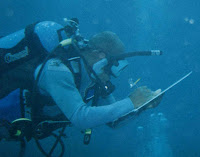 February and March marked the beginning of the MPA exploratory diving. Travelling via boat and motorized pirogue north to the islands of Nosy Ve, Nosy Mitata, Nosy Masai, and Andrombala.
February and March marked the beginning of the MPA exploratory diving. Travelling via boat and motorized pirogue north to the islands of Nosy Ve, Nosy Mitata, Nosy Masai, and Andrombala.
The second day took us to another potential MPA site with which again was not that impressive, proving to be more rubble than hard coral and with a low fish diversity.
That afternoon we visited the village of Antsatsamoroy to host a meeting in which the villagers were to create a map of their favourite fishing grounds. The meeting started off slow with only a few fishermen willing to divulge their best fishing sites. Eventually an elderly man, probably a nahuda (chief), began to chatter. He was full of local fishing knowledge and seemed happy to help us.
We worked hard, coming up with a map of 5 different reefs which contain high fish abundance. The map was then signed by all the nahudas as a mark of ownership and trust.
The meeting ended around dusk due to the timely arrival of the local gendarme, the mosquitoes! The villagers requested toaka gasy or rum in order to appease the fomba. Garth gave in to the request and bought three bottles as a present for the participants.
That night we camped on the island of Nosy Mitata on the beach under the stars. It was a full moon and quite hot due to the lack of wind in the region. However it was still spectacular. That night under the stars with a beer, we discussed the parameters for choosing a no take zone. I learned it is equally important to choose a site with high hard coral cover as well as high fish diversity, and also how it has been demonstrated to be equally successful to choose three small patch sites, as it is to choose one large patch site. Although the site must be large enough so that the fishermen may recognize the perimeter.
The third day I made two dives, one a deep dive and one shallower at Bela Mer. I thought these two sites were much more promising than the first two. The first dive would prove more difficult to conduct scientific surveys on because the top of the reef is at 16meters, however this should not disqualify it as a potential site.
The second dive was proclaimed to be a popular shallow fishing hole for the villagers. It was also an amazing dive. I saw many butterfly fish, which are an indicator species for coral reef health. I also spotted sea cucumber, an octopus, and an abundance of varied fish and coral species.
That afternoon, Garth, Simon, Bic, and returned to Ampasy to snorkel the site once again. The day was long, hot, and most of all exhausting, but in the end very rewarding. I look forward to future visits to neighbouring islands to learn more about the MPA process. It is one thing to sit in on a lecture and another to actually participate in the meeting and learn by action.
The three day voyage to the northern islands was much enjoyed; I hope the opportunity arises again.
Anne Furr (long term Volunteer)

